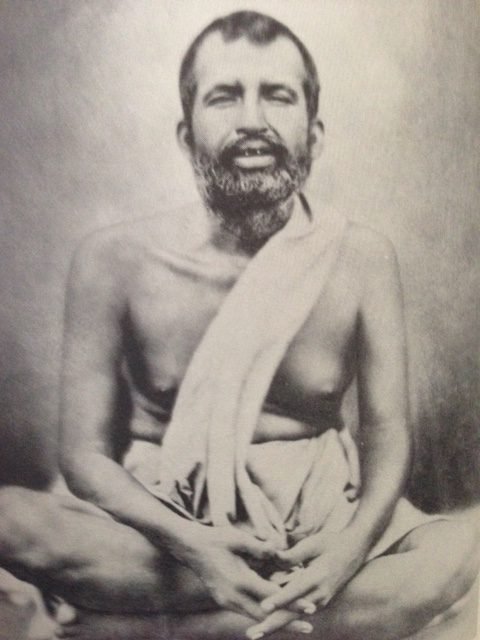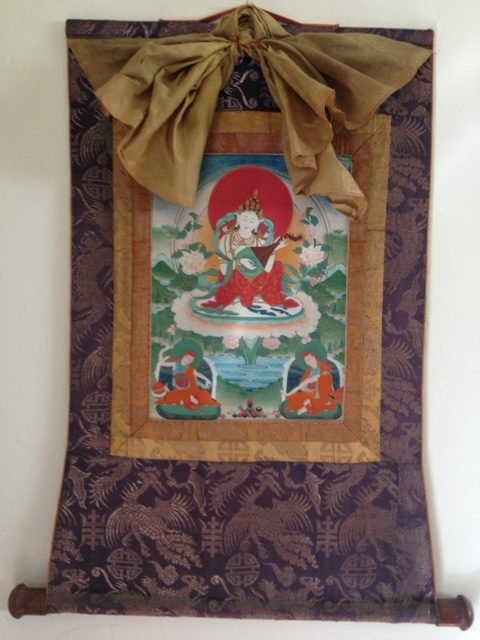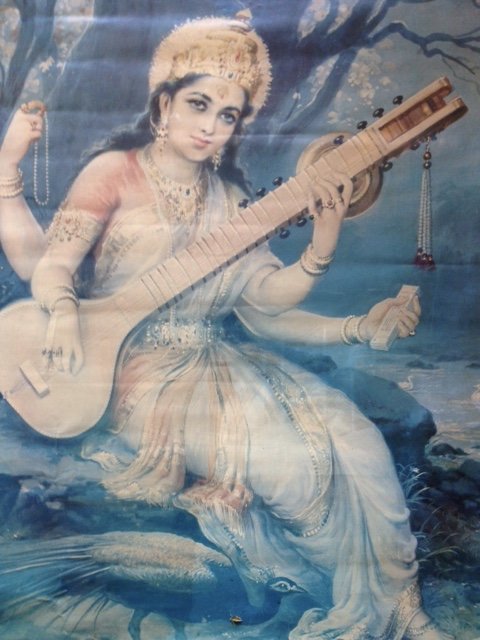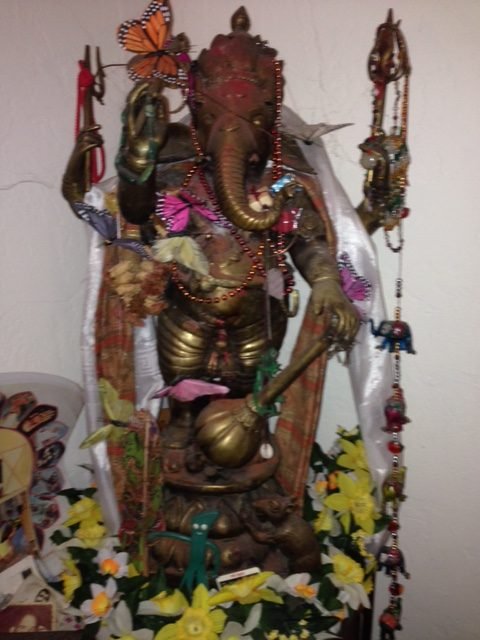Early Awakenings Through Hinduism
Hinduism began shaping my spiritual heart when I was in my teens, in the streets of Seattle. A group of Hare Krishna’s chanted and pogoed regularly in Pike Place Market, one of my first and favorite haunts as an independent teenager. I loved the drums, the tennis shoes, and haircuts. More than that though was a feeling of butterflies hatching from a place I was just remembering. Little did I know that this introduction to kirtan and Hinduism was just a sliver of what would grow into branches over several more decades.
Recognition
The direction of my spiritual path has often been guided with dreams. One night I dreamt a wise being handing me a little black book that was later to become a lampost in my life. The next day I felt compelled to abruptly leave my 9th grade English class, mumbling an excuse to my understanding teacher (the same teacher who led me to the Dharma as an 8th grader.)
I drove into Seattle, headed for a well-known and well-worn bookstore. My arm dove into the shadows of a second layer of old books and there it was: A very old, hardcover black translation of the Bhagavad Gita. I was amazed and swelled with some of the first tears of recognizing a deep to connection to truth and wisdom on levels known and unknown. Arjuna’s challenges took the floorboards out of my life and exchanged them for devotion.
Devotion
Around this time I became engrossed in Ram Dass’s Be Here Now. Love, surrender, recognition, devotion…layer by layer, the story, language, and images from that book pushed some kind of reset button in my soul’s recognition of itself. The mantras from Be Here Now became my inner sound, well worn as favorite pocket rocks. I maintained or returned to mental stability with them. I sang them when driving. I hummed them with my horses. Late at night, I would have visions of deities as the mantras droned.
Not only did that book change my life, it also opened me up to one of my first teachers, Neem Karoli Baba. I began having dreams of the “fat man on the blanket,” each which was a teaching or transmission of some kind. Later, when I moved to California, I would befriend many of Maharaji’s original satsang. Neem Karoli Baba was known as an incarnation of Hanuman. Hanuman also began showing up in my dreams, changing shape and form magically, giving guidance and playing in the winds of my dream and real-time. When my root lama Ven. Dhubthob Rinpoche stayed with me for a month, we went to house blessings at the homes of many of Neem Karoli Baba’s satsang. It was a joy to hear Rinpoche talk about the connection between Hanuman and Chenresig, and the relationship between other Hindu and Buddhist deities.
Serve
I also began dreaming about Sri Ramakrishna, “the crazy cross-dresser who loved God and fell down in bliss when he saw cows” as my friend Charlie described him. Once again, in my same English class, I had to leave, drove to a bookstore, reached deep into the stacks put my hands on a beautiful copy of “The Gospel of Sri Ramakrishna” which became my constant companion. Sri Ramakrishna’s “falling into rapture at seeing a cow because it reminded him of Krishna” really appealed to me.
How convenient, to see the bliss of God/Spirit in every moment! This would become my goal, supported deeply with all that came into my spiritual life afterward. Sri Ramakrisha’s teachings also opened me up to the relationship eroticism has with ecstatic bliss. His teachings emphasized “both/and” as opposed to “either/or.” Pomegranate is one fruit but many seeds. I still don’t see Hinduism and Buddhism as polytheistic compared to Christian faith traditions, but as facets of the same, a more magnified view.
Love
As step-by-step as the Zen Ox herding Pictures, the study of Hindu masters and classics opened and continues to open a very devotional part of my experience. One well-seasoned friend said, “Susan, you are a bhakta of the first degree! It is not just the dharma you love, it is god!” Stories and teachings from such great masters as Neem Karoli Baba, Sri Ramakrishna, Sri Nisargadatta, and others have completely and eloquently supported my long-time study of Tibetan Buddhism. Equally, the heart-opening love and kriya I have felt from the teachings of those saints have given me the experience of the vast devotion and faith in the path and fruits of the teachings. Servitude to their teachings and different manifestations has given me great strength in trying times and has ultimately helped me make a new bridge to my Christian roots.
Other Hindu gods began making their way into my subconscious. I felt a Mary/Tara-like love for Saraswati, and invoked her wonderful inspiration in different writing and music projects. Later, the gift of my first Tibetan thanka was of a beautiful Saraswati. She still oversees the “art and creativity” corner of my home. Now and then I feel the deep grace of Sariswati. Her qualities are a good balance to my deeply practical, Taurean approach to my artistic side.
Ganesh represents to me the “Perfection of Generosity” from the Tibetan Buddhist Six Perfections, but with an intact sense of humor. During my poorest year, Ganesh, the elephant god of wealth and prosperity and removal of obstacles, appeared in a dream as a big painted bus that attracted people like magnets. The whimsical story of his life spun cartoons into my subconscious.
When my daughter was 3 years old, she claimed him has the star of her animal pantheon. Years later after opening a shop of Himalayan goods, I was delighted to see all the statues of Ganesh in his various forms: laying down, dancing on one leg, sitting with his rodent friend, and my favorite, him breakdancing.
A temple my lama founded in Pharping, Nepal is built around a self-emerging rock image of Ganesh and Tara. One day, a local there said it is rumored that Ganesh sheds tears of Amrit when in the presence of those with great devotion, but that he had never seen it happen himself. One local had seen this 30 years ago. As he spoke I saw those very tears form and drop and pointed them out. The man became speechless. We all were stunned by this amazing display. As the tears rolled down the rock face, a little mouse emerged and enjoyed some of the offerings that lay at the feet of the images. Om Ganesha! Om Tara!
Surrender
My most intimate and long-standing relationship with a Hindu deity is not with one of the warm fuzzy ones. For years I seemed to be chained to Kali, the Goddess of Destruction, Destroyer of all illusion, Palden Lhamo. During my dark night of the soul having to do with the loss of use of my hands and arms, Kali consumed and spit out all I had worked toward. She taught me that no bargains were allowed-she might, could, and would crush any and everything in my life no matter how good of a person I was.
Impermanence, attachment. Clinging, ego, delusion…all became croutons in the cold soup she dished up for me, day after day, year after year. Behind the shadow of Palden Lhamo though, is a wonderful loving Tara. I smiled, kicked, screamed, and surrendered to Kali, with appeals to Tara.
My experiences with Hindu and Buddhist teachers and teachings have formed two main pillars in the temple of me. On the feeling level, Hindu teachings and deities bring a different kind of joy and celebration that is integrated into the darkest corners of my being. This helps balance some of the practices of Tibetan Buddhism which are more like the chair in the room, commanding a solid presence, making room for devotion and bliss in a more calculated, almost solemn way.
My life is constantly being caressed by the devotion of Hanuman, the obstacle-clearing and wealth of Ganesh, and the art, beauty, and inspiration of Sariswati. The sense of mela, celebration, is alive in that experience. I celebrate all the ways Hinduism has shaped my core expression of spirit. Being a bhakta has been a blissful existence for me and is a big reason why I found such joy in my journey of Interfaith Education.
Sub Iswar Hai!!!!
Ram Ram!!!
Om Tat Sat!!!!
It’s all God!
God God!
The Supreme Absolute Truth!








